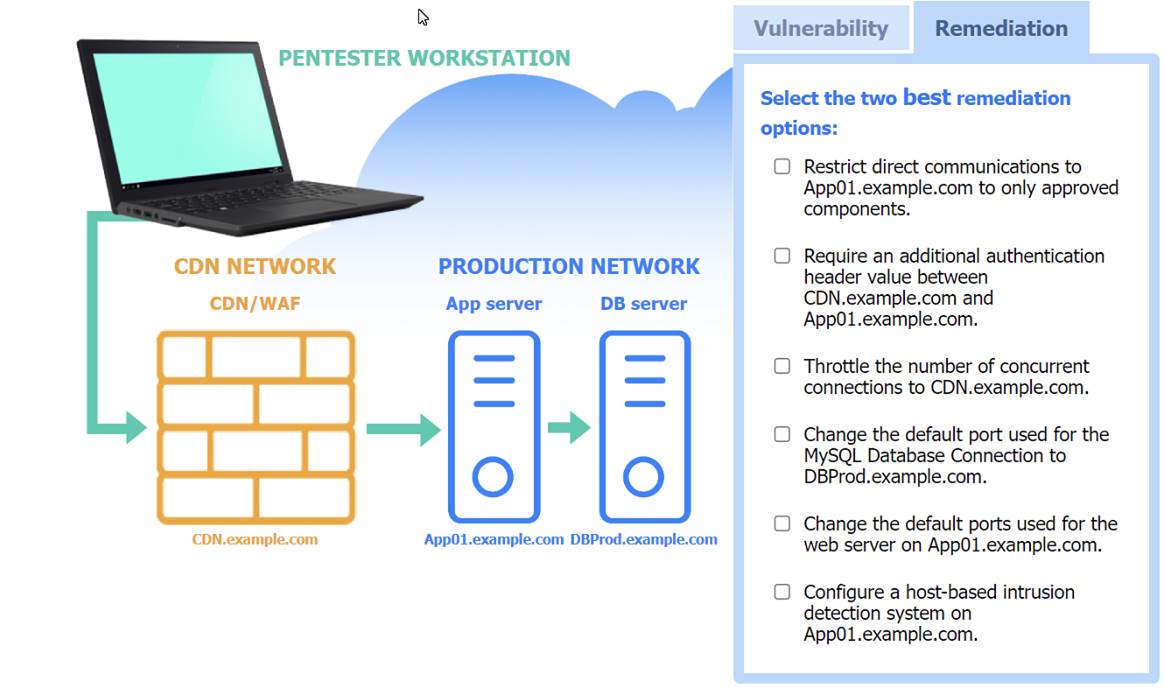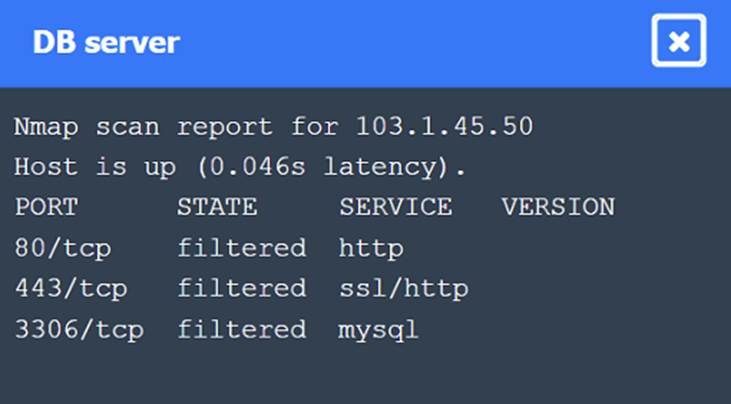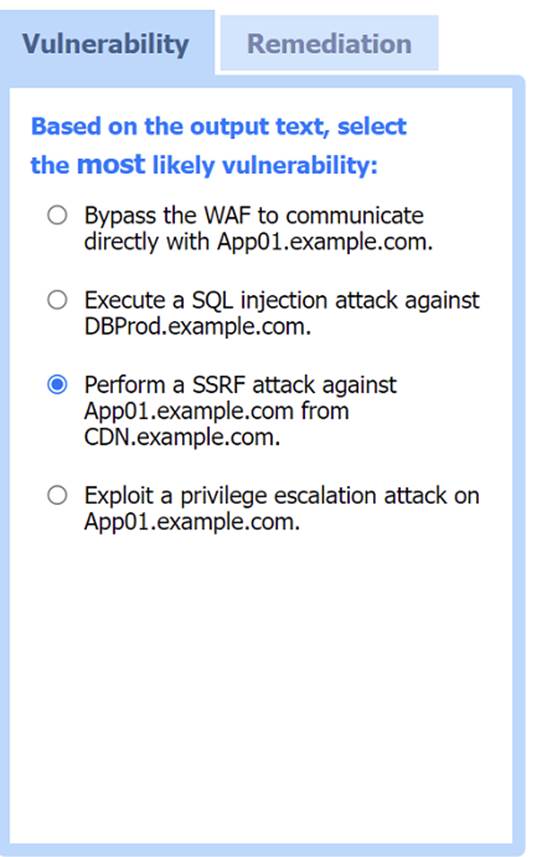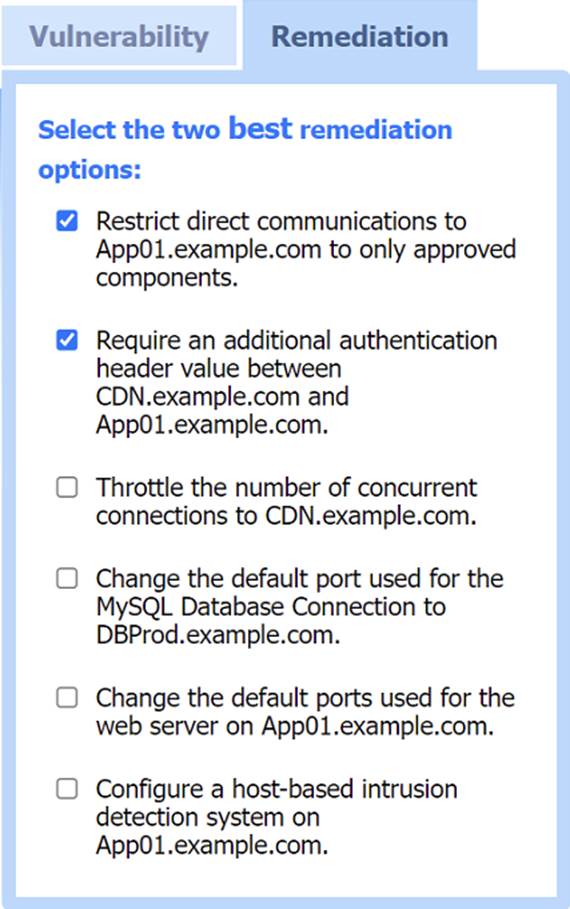A penetration tester needs to evaluate the order in which the next systems will be selected for testing. Given the following output:
Hostname | IP address | CVSS 2.0 | EPSS hrdatabase | 192.168.20.55 | 9.9 | 0.50
financesite | 192.168.15.99 | 8.0 | 0.01
legaldatabase | 192.168.10.2 | 8.2 | 0.60
fileserver | 192.168.125.7 | 7.6 | 0.90
Which of the following targets should the tester select next?
Correct Answer:
A
Given the output, the penetration tester should select the fileserver as the next target for testing, considering both CVSS and EPSS scores. Explanation
✑ CVSS (Common Vulnerability Scoring System):
✑ EPSS (Exploit Prediction Scoring System):
✑ Evaluation:
Pentest References:
✑ Prioritization: Balancing between severity (CVSS) and exploitability (EPSS) is crucial for effective vulnerability management.
✑ Risk Assessment: Evaluating both the impact and the likelihood of exploitation helps in making informed decisions about testing priorities.
By selecting the fileserver, which has a high EPSS score, the penetration tester focuses on a target that is more likely to be exploited, thereby addressing the most immediate risk.
=================
A penetration tester is conducting a vulnerability scan. The tester wants to see any vulnerabilities that may be visible from outside of the organization. Which of the following scans should the penetration tester perform?
Correct Answer:
C
To see any vulnerabilities that may be visible from outside of the organization, the penetration tester should perform an unauthenticated scan.
✑ Unauthenticated Scan:
✑ Comparison with Other Scans:
✑ Pentest References:
By performing an unauthenticated scan, the penetration tester can identify vulnerabilities that an external attacker could exploit without needing any credentials or internal access.
=================
During an engagement, a penetration tester needs to break the key for the Wi-Fi network that uses WPA2 encryption. Which of the following attacks would accomplish this objective?
Correct Answer:
D
KRACK (Key Reinstallation Attack) exploits a vulnerability in the WPA2 protocol to decrypt and inject packets, potentially allowing an attacker to break the encryption key and gain access to the Wi-Fi network.
✑ Understanding KRACK:
✑ Attack Steps:
✑ Impact:
✑ Mitigation:
✑ References from Pentesting Literature: Step-by-Step ExplanationReferences:
✑ Penetration Testing - A Hands-on Introduction to Hacking
✑ HTB Official Writeups
=================
Which of the following is most important when communicating the need for vulnerability remediation to a client at the conclusion of a penetration test?
Correct Answer:
B
When concluding a penetration test, effectively communicating the need for vulnerability remediation is crucial. Here??s why the articulation of impact is the most important aspect:
✑ Articulation of Cause (Option A):
✑ Articulation of Impact (Option B):
✑ Articulation of Escalation (Option C):
✑ Articulation of Alignment (Option D):
Conclusion: Articulating the impact of vulnerabilities is the most crucial element when communicating the need for remediation. By clearly explaining the potential risks and consequences, penetration testers can effectively convey the urgency and importance of addressing the discovered issues, thus motivating clients to take prompt and appropriate action.
SIMULATION
A penetration tester performs several Nmap scans against the web application for a client. INSTRUCTIONS
Click on the WAF and servers to review the results of the Nmap scans. Then click on each tab to select the appropriate vulnerability and remediation options.
If at any time you would like to bring back the initial state of the simulation, please click the Reset All button.




Solution:

Most likely vulnerability: Perform a SSRF attack against App01.example.com from CDN.example.com.
The scenario suggests that the CDN network (with a WAF) can be used to perform a Server-Side Request Forgery (SSRF) attack. Since the penetration tester has the pentester workstation interacting through the CDN/WAF and the production network is behind it, the most plausible attack vector is to exploit SSRF to interact with the internal services like App01.example.com.
Two best remediation options:
✑ Restrict direct communications to App01.example.com to only approved components.
✑ Require an additional authentication header value between CDN.example.com and App01.example.com.
✑ Restrict direct communications to App01.example.com to only approved components: This limits the exposure of the application server by ensuring that only specified, trusted entities can communicate with it.
✑ Require an additional authentication header value between CDN.example.com
and App01.example.com: Adding an authentication layer between the CDN and the app server helps ensure that requests are legitimate and originate from trusted sources, mitigating SSRF and other indirect attack vectors.
Nmap Scan Observations:
✑ CDN/WAF shows open ports for HTTP and HTTPS but filtered for MySQL, indicating it acts as a filtering layer.
✑ App Server has open ports for HTTP, HTTPS, and filtered for MySQL.
✑ DB Server has all ports filtered, typical for a database server that should not be directly accessible.
These findings align with the SSRF vulnerability and the appropriate remediation steps to enhance the security of internal communications.
Does this meet the goal?
Correct Answer:
A

